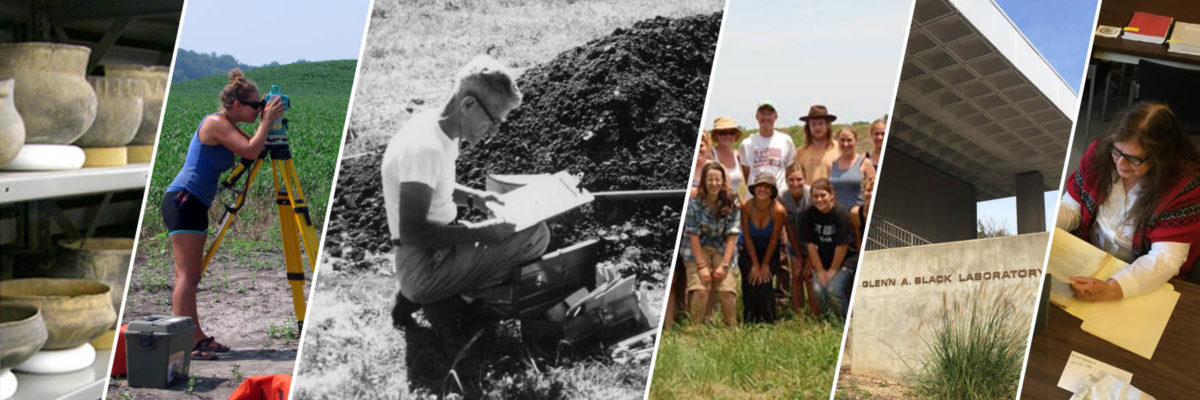by Amanda Burtt
Hello All! My name is Amanda Burtt and I am one of the newest members of the IMLS funded Curating Angel project that is underway right now. My job as Associate Curator for the rehousing project includes helping lead a team of graduate and undergraduate students in the many steps involved in transferring the Angel Mounds archaeological collections from their original storing containers to archival grade curation bags and boxes.
In addition to working for the Glenn A. Black Laboratory on the Angel project, I am also a PhD candidate in the Anthropology Department here at Indiana University. I am an archaeologist with a specialization in zooarchaeology. Zooarchaeologists analyze animal remains (bones, teeth, shells, fur, etc.) from archaeological sites to better understand ways that people interacted with animals in the past, which can vary greatly, from food resource to companion to deity. My dissertation research investigates the diets of domestic dogs in Precontact North America. I am able to examine dog diets by employing Dental Microwear Texture Analysis (DMTA), which evaluates the surface of a tooth to determine what kinds of food textures a dog is accessing. This method can determine if dogs are heavily processing bone for nutrition, a sign of food stress. This method has allowed me to quantify when dogs are allowed access to flesh or cooked foods or are utilizing lower quality foodstuff (i.e. bones).

Lucky for me, the Angel curation project began with re-housing the fauna remains recovered from Angel Mounds. Which means I get to spend my work days opening bags (some haven’t been opened since their original bagging in the 1940’s) and seeing the remains of animals that shared the landscape with Indigenous communities that occupied Angel Mounds hundreds of years ago. My research interests extend beyond dogs; I am also interested in ways that humans in the past interacted with carnivores more broadly. One of the fascinating things I have observed while rehousing fauna remains is the abundance of raccoons (scientific name Procyon lotor) in the Angel Mounds assemblage. Since my first day working with the Angel Mounds fauna, I noticed evidence of raccoons from all parts of the skeleton, including teeth, skulls, long bones, and even the baculum (which is a bone found in the penis of many placental mammals).

The mandible (lower portion of the skull) is a bone that is both recognizable and dense enough to survive the deposition and excavation processes. We have found many mandibles belonging to raccoons and the following image shows two (circled in the picture). Of interesting note, the left mandible exhibits extreme dental wear when compared to the one on the right. You will notice that the molars of the left raccoon appear flat while the mandible on the right still has prominent cusps. Also, both mandibles are from the right side meaning there are at least two raccoons represented in this subsample. This is a quantification method that zooarchaeologists use called MNI (minimum number of individuals).

Like dogs, raccoons also belong to the taxonomic order Carnivora. Though also like dogs, raccoons tend to be omnivorous as they will seek out food resources that are available and usually do not pass up the opportunity for a meal. We have seen many worn molars from raccoons while rehousing the Angel fauna, which has me wondering why. My current theory is that the residents of Angel Mounds were keeping the predator population in check and raccoons were able to survive well into adulthood resulting in elder raccoons with advanced worn teeth. This theory is among many that my coworkers and I hypothesize while working side by side rehousing animal bones. Though there is evidence of predators among the assemblage, including black bears and bobcats, their remains do not compare to the amount of raccoons we are finding. We will keep thinking on theories and keep you posted!
More About IMLS
The Institute of Museum and Library Services is the primary source of federal support for the nation’s libraries and museums. We advance, support, and empower America’s museums, libraries, and related organizations through grantmaking, research, and policy development. Our vision is a nation where museums and libraries work together to transform the lives of individuals and communities. To learn more, visit www.imls.gov and follow us on Facebook and Twitter.

(The views, findings, conclusions, or recommendations expressed in this blog post do not necessarily represent those of the Institute of Museum and Library Services.)

